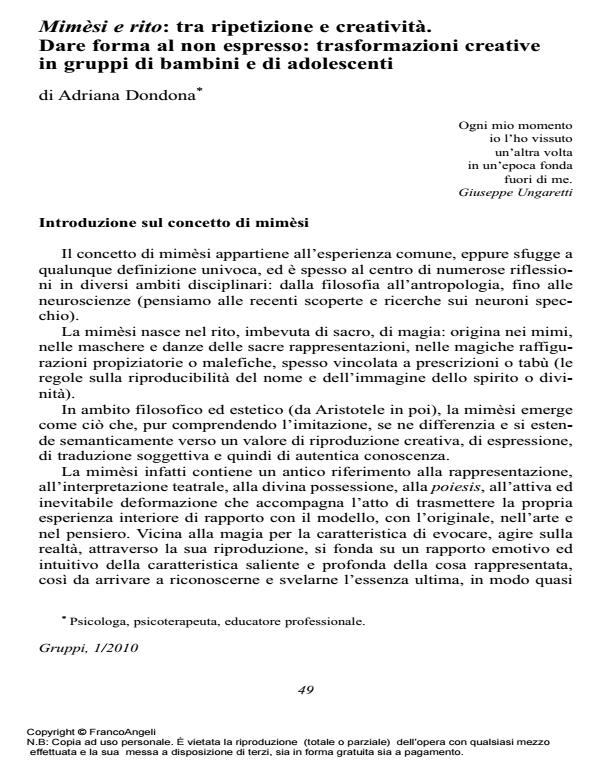Mimesis and rites: between repetition and creativity. Giving shape to the unexpressed: creative changes in groups of children and teenagers
Journal title GRUPPI
Author/s Adriana Dondona
Publishing Year 2010 Issue 2010/1
Language Italian Pages 14 P. 49-62 File size 319 KB
DOI 10.3280/GRU2010-001005
DOI is like a bar code for intellectual property: to have more infomation
click here
Below, you can see the article first page
If you want to buy this article in PDF format, you can do it, following the instructions to buy download credits

FrancoAngeli is member of Publishers International Linking Association, Inc (PILA), a not-for-profit association which run the CrossRef service enabling links to and from online scholarly content.
This abstract describes the experience of therapeutic and experiential groups conducted in primary and secondary schools and in an infantile neuropsychiatry service "an ASL in Rome" with children and teenagers with learning and behavioral problems that are often correlated with their social life and family environment. Clinical examples illustrate how mimesis and rituals are used by children in groups to experience less repetitive and stereotyped representations of themselves and to delineate a new, original and subjective narration of their own emotional and relational world. Mimesis generates emotional and imaginative contagion, and is a magnetic force that triggers the working groups’ thought, syncretic sociability, the formation of alliances, complicity and antagonism; it stimulates mirroring, empathy, and the construction of transitional "self-objects". Furthermore, mimesis produces both conformist phenomena and opportunities for change, helping to overcome passive imitation, so as to find its own way of reproducing reality. Creative mimesis, which the group comes to discover, captures what is ambiguous and undifferentiated in experience, so as to offer a new expression which contains unexplored parts of Self, together with what is happening and what we encounter. Thus, while reproducing well-known social forms that are often endured, ritual group action creates a symbolic evocative frame that breaks the indistinct flow of existence and encourages the children to "play" with the search for meaning, with the expectations, paradoxes and obscure moments of experience, by destroying and rebuilding what is customary. For these children and teenagers "who are too conditioned by approval models, and on a psycho-emotional level are often exposed to such traumatic or deeply ambivalent experiences that they feel filled with projected needs and other people’s desires, and are expropriated of vital areas of expressiveness" it is important to experiment a mimesis that does not copy, but reinterprets otherness, in a constant pull between aliena- tion and subjectivity, to build an independent and creative process of individual and collective growth.
Keywords: Subjectivity, repetition, creativity, therapeutic and transformative factors, psychosocial discomfort
Adriana Dondona, Mimèsi e rito: tra ripetizione e creatività. Dare forma al non espresso: trasformazioni creative in gruppi di bambini e di adolescenti in "GRUPPI" 1/2010, pp 49-62, DOI: 10.3280/GRU2010-001005